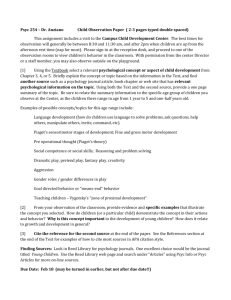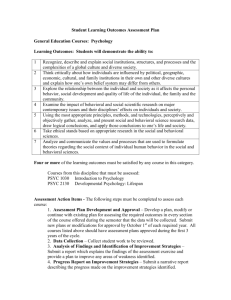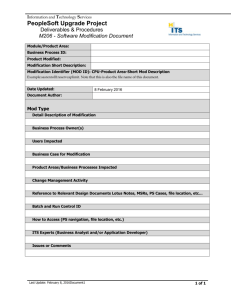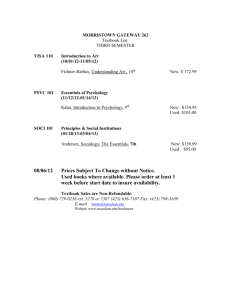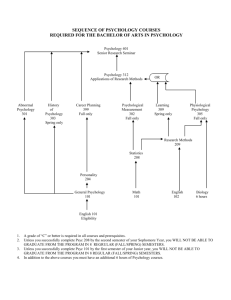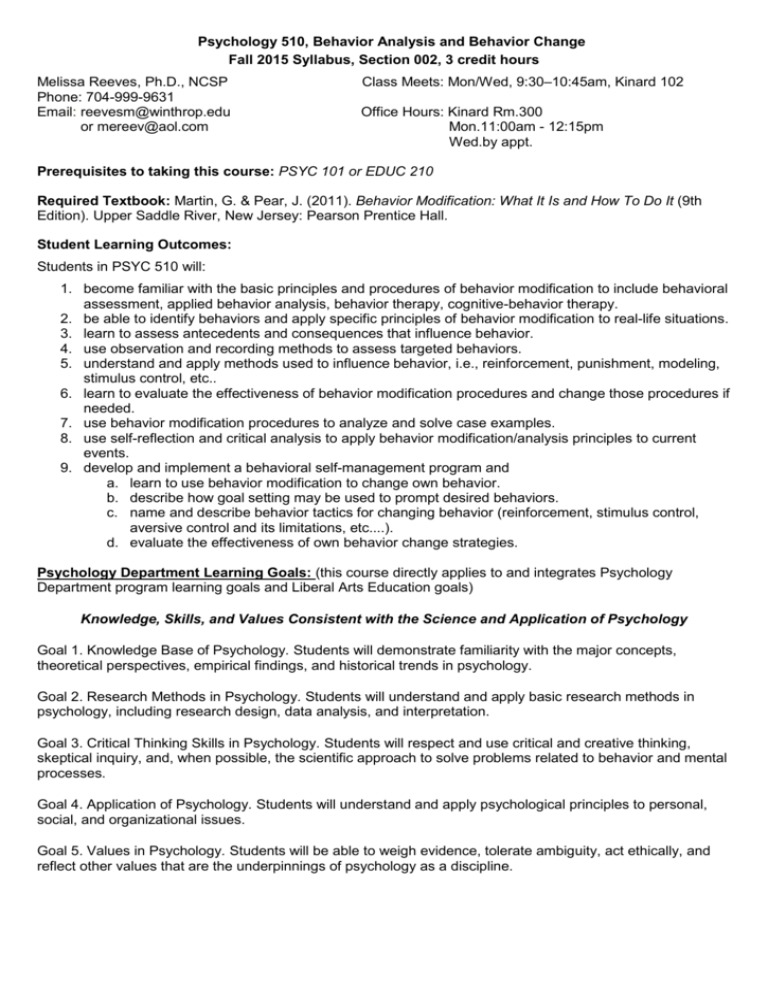
Psychology 510, Behavior Analysis and Behavior Change
Fall 2015 Syllabus, Section 002, 3 credit hours
Melissa Reeves, Ph.D., NCSP
Phone: 704-999-9631
Email: reevesm@winthrop.edu
or mereev@aol.com
Class Meets: Mon/Wed, 9:30–10:45am, Kinard 102
Office Hours: Kinard Rm.300
Mon.11:00am - 12:15pm
Wed.by appt.
Prerequisites to taking this course: PSYC 101 or EDUC 210
Required Textbook: Martin, G. & Pear, J. (2011). Behavior Modification: What It Is and How To Do It (9th
Edition). Upper Saddle River, New Jersey: Pearson Prentice Hall.
Student Learning Outcomes:
Students in PSYC 510 will:
1. become familiar with the basic principles and procedures of behavior modification to include behavioral
assessment, applied behavior analysis, behavior therapy, cognitive-behavior therapy.
2. be able to identify behaviors and apply specific principles of behavior modification to real-life situations.
3. learn to assess antecedents and consequences that influence behavior.
4. use observation and recording methods to assess targeted behaviors.
5. understand and apply methods used to influence behavior, i.e., reinforcement, punishment, modeling,
stimulus control, etc..
6. learn to evaluate the effectiveness of behavior modification procedures and change those procedures if
needed.
7. use behavior modification procedures to analyze and solve case examples.
8. use self-reflection and critical analysis to apply behavior modification/analysis principles to current
events.
9. develop and implement a behavioral self-management program and
a. learn to use behavior modification to change own behavior.
b. describe how goal setting may be used to prompt desired behaviors.
c. name and describe behavior tactics for changing behavior (reinforcement, stimulus control,
aversive control and its limitations, etc....).
d. evaluate the effectiveness of own behavior change strategies.
Psychology Department Learning Goals: (this course directly applies to and integrates Psychology
Department program learning goals and Liberal Arts Education goals)
Knowledge, Skills, and Values Consistent with the Science and Application of Psychology
Goal 1. Knowledge Base of Psychology. Students will demonstrate familiarity with the major concepts,
theoretical perspectives, empirical findings, and historical trends in psychology.
Goal 2. Research Methods in Psychology. Students will understand and apply basic research methods in
psychology, including research design, data analysis, and interpretation.
Goal 3. Critical Thinking Skills in Psychology. Students will respect and use critical and creative thinking,
skeptical inquiry, and, when possible, the scientific approach to solve problems related to behavior and mental
processes.
Goal 4. Application of Psychology. Students will understand and apply psychological principles to personal,
social, and organizational issues.
Goal 5. Values in Psychology. Students will be able to weigh evidence, tolerate ambiguity, act ethically, and
reflect other values that are the underpinnings of psychology as a discipline.
PSYC 510, p. 2
Knowledge, Skills, and Values Consistent with Liberal Arts Education that are Further Developed in
Psychology
Goal 6. Information and Technological Literacy. Students will demonstrate information competence and the
ability to use computers and other technology for many purposes.
Goal 7. Communication Skills. Students will be able to communicate effectively in a variety of formats.
Goal 8. Sociocultural and International Awareness. Students will recognize, understand, and respect the
complexity of sociocultural and international diversity.
Goal 9. Personal Development. Students will develop insight into their own and others’ behavior and mental
processes and apply effective strategies for self-management and self-improvement.
Goal 10. Career Planning and Development. Students will emerge from the major with realistic ideas about
how to implement their psychological knowledge, skills, and values in occupational pursuits in a variety of
settings
Class Format:
The class will be taught in such a way as to increase the likelihood that each student will both understand the
course content and be able to apply course content in “real world” situations. Methods of instruction may
include the following:
1. Discussion groups
2. Lecture and video presentations
3. Group problem solving with sample cases
4. Outside experiences
5. Student presentations
It is very important that each student be an active member of the class by volunteering in discussions and
problem-solving strategies. The instructor will not force participation by focusing on individuals. Rather, it will
be the responsibility of each student to take the appropriate initiative.
Course Requirements:
1. Three exams will be given; each will contain various question formats. The final exam will be integrative
and cumulative in nature.
2. Self-Directed Behavior Change project. (see pgs. 4-6).
3. Kids on Race Assignment (see p. 7)
4. Class participation
5. Possible Extra Credit Opportunities –
a. Research Participation. All research projects have been approved by the Winthrop University Institutional Review
Board (IRB) and are supervised by one or more Winthrop faculty. If available, you will have the opportunity to
participate in one or more research studies. These will be announced in class. Each experiment lasts anywhere
from a few minutes to 2 or more hours. 5 extra credit points per hour of participation will be applied towards your
class grade and you may earn a maximum of 10 class extra credit points. If you participate less than one hour, I
will round this up to 5 extra class points. I will not see your responses to any of the experiments. Experiment
spots are limited and available on a first come, first serve basis.
Assessment and Grading:
Three exams
Self-Change Project Proposal
Self-Change Project: Final Project
AC360: “Kids on Race” Assignment
TOTAL POINTS FOR CLASS
Graduate Students:
Research Paper
TOTAL POINTS FOR CLASS
Grading Scale:
300 pts
70 pts
80 pts
100 pts
550 pts
A = 90% and above
B+ = 87-89%
B = 80%-86%
C+ = 77%-79%
C = 70%-76%
+ 100 pts
650 pts
2
D+ = 67%-69%
D = 60%-66%
F = 59% and below
PSYC 510, p. 3
Attendance Policy: Class participation and attendance are important. When more than 3 absences are
unexcused, 10 points per absence will be deducted from your overall grade. In addition, it is important to
be on time because of planned activities. If you arrive after attendance is taken, you may be counted absence.
Participation is considered in grading.
Possible Changes in Syllabus: Unanticipated circumstances may require slight changes in the syllabus. The
instructor has the discretion to make changes or modifications to the syllabus if needed, however students will
be provided notice of these changes and deadlines may be adjusted accordingly.
Late Assignments: There will be a 5-point per day penalty for late assignments (e.g. if assignment is due Mon.
and you turn it in on Wed. 10 points will be deducted from total grade). Assignments will not be accepted one
week past due date and thus will result in an automatic zero. In extenuating circumstances, the due date may
be extended beyond one week but only if you have contacted me before the due date to discuss situation
and possible extension.
Submit Paper Copies of Assignments: All written work is to be submitted typed and using APA style
formatting, if applicable. I will NOT be receiving assignments by email.
Make-up exams: Make-up exams will be given only in cases of illness or family emergencies. I must be
notified before the exam. If you fail to notify me by phone or email before the exam, a score of zero will be
given for the exam. If we schedule a make-up exam and you fail to show-up to take the make-up exam, no
additional make-up exams are allowed and a score of zero will be given.
Course Incompletes: An incomplete for this course will be given only in very unusual circumstances with
appropriate documentation supporting that you are not able to complete the course at this time.
Cell Phone Usage: Cell phones are to be turned off or muted during class. Talking on the cell phone or text
messaging during class is strictly prohibited. If this guideline is not followed, you will be asked to leave class
and you will be counted as absent for that class period.
Winthrop’s Academic Success Center (ASC) is a free resource for all undergraduate students seeking to
perform their best academically. The ASC offers a variety of personalized and structured resources that help
students achieve academic excellence, such as tutoring, academic skill development (test taking strategies,
time management counseling, and study techniques), group and individual study spaces, and academic
coaching. The ASC is located on the first floor of Dinkins, Suite 106. Please contact the ASC at 803-3233929 or success@winthrop.edu. For more information on ASC services, please visit
www.winthrop.edu/success.
Students with Disabilities/Need of Accommodations for Access: Winthrop University is committed to providing
access to education. If you have a condition which may adversely impact your ability to access academics
and/or campus life, and you require specific accommodations to complete this course, contact the Office of
Disability Services (ODS) at 803-323-3290, or, accessibility@winthrop.edu. Please inform me as early as
possible, once you have your official notice of accommodations from the Office of Disability Services.
Academic Misconduct: As noted on the Student Code of Conduct Statement, “Responsibility for good conduct
rests with students and adult individuals.” Cheating, plagiarism, or other dishonest or inappropriate behaviors
result in consequences. These behaviors will result in a grade of zero on the assignment or test that is
affected and could result in a grade of F in the course. The full policy on student academic misconduct is
outlined in the “Student Conduct Code Academic Misconduct Policy” in the online Student Handbook
(http://www2.winthrop.edu/studentaffairs/handbook/StudentHandbook.pdf).
Office of Victims Assistance (OVA): provides services to survivors of sexual assault, intimate partner violence,
and stalking as well as educational programming to prevent these crimes from occurring. The staff assists all
survivors, regardless of when they were victimized in obtaining counseling, medical care, housing options,
legal prosecution, and more. In addition, the OVA helps students’ access support services for academic
problems resulting from victimization. OVA is located in 204 Crawford , (803) 323-2206; after-hours
emergency, call Campus Police at (803)323-3333, or the local rape crisis center, Safe Passage-24-hour hotline,(803)329-2800. For more information please visit: http://www.winthrop.edu/victimsassistance/
3
PSYC 510, p. 4
COURSE ASSIGNMENTS
1) SELF DIRECTED BEHAVIOR CHANGE PROJECT
The self-directed behavior change project is to be submitted in two parts. Due dates are specified in the
syllabus. We will discuss in class how to select a target behavior for this project. Listed below are some
examples. You are welcome to choose some other behavior not on the list, pending instructor approval.
Increasing assertiveness
Decrease insomnia/increasing sleep
Increasing/decreasing phone calls
Decreasing road rage
Decreasing anger/yelling
Decreasing tobacco consumption
Decreasing physical punishment
Increasing exercise
Decreasing controlling behaviors
Decreasing alcohol/drug consumption
Decreasing text messaging while driving
Increasing healthy eating habits
Increasing use of a daily organizer
Increasing productive work habits
Decreasing depression
Decreasing obsessive/compulsive behaviors
Decreasing phobic/fear reactions
Increasing/decreasing positive/negative self-talk
Increasing positive relationship style
Increasing task performance (test scores, tennis, meals
cooked at home)
Decreasing calorie intake
Part I. Proposal for Self-Directed Behavior Change Project (70 points).
(Note: If you do not complete the Part 1: Contract and Proposal assignment, you receive a score of a zero for
both the proposal and the Final Project Report.):
Paper should be single spaced and integration of concepts being learned is critical to earning a good grade.
Develop your Intervention Plan
Using the outline below you will expand on each section to describe your proposed intervention plan.
1. Measurable Goals (5pts)
a) Write an overall behavioral goal you want to achieve by changing a behavior this semester.
b) Operational Definition: Select one behavior (target behavior) you are going to change that will
help you reach your overall goal and write a behavioral objective to include an operational
definition that is specific and measurable.
c) Explain how and why you selected this goal and behavioral objective.
2. Baseline data observation, recording, and graphing methods (25pts)
Baseline Data Collection: Present an assessment of your baseline level of behavior to include
observation and self-recording. Your assessment must include the following:
a. An “ABC” diary/chart with an “antecedent—behavior—consequences” format. (Be sure to
record both when target behavior is and is not occurring.)
********At this time, just observe, don’t change your behavior.*******
e.g. ABC Analysis
Date/Time/Place
Antecedent (A)
What happened before
behavior occurred?
Target Behavior (B)
To include
Frequency/Duration/Latency
Consequence(s) (C)
What happened following
behavior? (thoughts and behaviors)
b. Collection of baseline data with a frequency/duration/latency count for at least 14 days. .
c. Develop a line or bar graph representing your baseline data. Be sure to label x and y axis’.
d. Describe how you conducted the self-observation and the specific type of recording method
used (integrate key concepts from your reading and class lectures).
e. Analyze the patterns that have emerged during baseline data collection.
f. Develop a hypothesis as to why the targeted behavior is or is not occurring at the level you are
seeking. Integrate course concepts.
g. Explain how you will continue data collection during your intervention phase (type of data,
recording method).
4
PSYC 510, p. 5
3. Conduct a literature review related to your behavioral change goal (15pts)
Provide a brief summary of at least 3 research articles (published in 2000 or later; peer reviewed or
journal articles, not website or website articles). The summary is to include a paragraph on each article
that:
a) briefly summarizes the article
b) highlights the behavioral modification techniques used to change that type of behavior
c) 2-3 sentences of what you learned from the article that you will integrate into your selfchange plan.
*Three research articles are required and MUST to be cited in APA format at the end of your summary. Once you
have included three research articles, you may supplement with legitimate website resources.
4. Proposed behavior/intervention plan to change behavior: (25 pts) Include:
a. Specific steps and strategies you will implement to change behavior (reinforcements, extinction,
etc.).
b. How you will manage situations and consequences (i.e. self-efficacy steps, strategies for selfcontrol as these help minimize the causes of the behavior, etc.).
c. What are possible obstacles to your goal of changing the target behavior and ways of overcoming
these obstacles? Include alternatives you will try if things don’t work out the way you planned.
d. The various types of rewards and reinforcement schedules you are utilizing.
e. How you will maintain commitment and prevent relapse?
f. How will you review progress?
****Integrate the behavioral terminology/concepts you read about in literature review articles and also
those you have learned in lectures and readings. This will be a large part of your grade.****
g. Sign your intervention plan.
** Note: You may need to revise/modify your plan when provided feedback by professor.
APA STYLE FOR CITATION IN PAPERS:
Within body of paper:
As stated by Reeves, Kanan, & Plog (2000), ………
The results of the study……………(Reeves, Kanan, & Plog, 2010).
[The author’s name is followed by the year the article was published]
Reference Citation- Book:
Reeves, M., Kanan, L., & Plog, A. (2010). Comprehensive Planning for Safe Learning Environments: A School
Professional's Guide to Integrating Physical and Psychological Safety: Prevention through Recovery. New
York: Routledge Publishing.
Reference Citation- Journal Article:
Brock, S. E., Nickerson, A. B., Reeves, M. R., Woitaszewski, S., & Savage, T. (2011). Development, evaluation,
and future directions of the PREPaRE School Crisis Prevention and Intervention Training Curriculum.
Journal of School Violence, 10, 34-52.
Article found through web: VandenBos, G,. Knapp, S., & Doe, J. (2001). Role of reference elements in the selection of
resources of psychology undergraduates. Journal of Bibliographic Research, 5, 117-123. Retrieved October 13, 2001,
from http://jbr.org/articles/html
5
PSYC 510, p. 6
2. Part II. Final Self-Directed Project Report (80 points). Use the following format. (For the final project you
will need to respond to and/or integrate the feedback provided by professor in your proposal and then
elaborate further to complete requirements listed below.)
*Your project grade will not be based upon the amount of behavior change, but rather on the thoroughness for
which you address the required areas listed above and integrate course concepts.
*Use study guides for exams and class lecture notes to help integrate key terminology.
1. Introduction (5pts)
a. Description of overall goal and behavioral objective (target behavior) to include operational
definition.
2. Method (20pts) - Actual Intervention Plan Implemented
a. Describe in detail the actual intervention plan and steps you implemented. This should contain
more strategies than listed in your proposal as you have now learned more in class that you
can integrate. Use class concepts and principles to describe plan and be specific on explaining
how you collected data, the recording method used, the length of data collection, antecedent
control, reinforcement, cognitive strategies, shaping, fading, etc…
i. How did you manage the situation, consequences, obstacles and challenges?
ii. What type of rewards and reinforcement schedules were used?
3. Results/Discussion/Critical Analysis (35pts)
a. Present data collected before, during, and after intervention in graphs and/or tables (e.g.
baseline graph and intervention graph). You should have at least 6 weeks of intervention data,
in addition to your baseline data.
b. Present a critical analysis of your project.
i. Identify patterns and themes which emerged.
ii. What behavior principles helped your intervention plan to be successful and/or what
behavior principles implemented were not as successful as hoped? Discuss your
results and outcomes integrating key concepts from class. Be sure to consider the
effectiveness of the intervention in relation to improvement over baseline and/or to
whether the objective was met within the timeline you specified.
iii. Describe how you dealt with problems and report any changes or adjustment you
needed to make to your intervention plan (e.g. maintain commitment or lack thereof,
effectiveness of reinforcements and reinforcement schedules, etc..)
4. Maintenance and Generalization (15pts)
a. What, if anything, would you do differently next time?
b. How do you plan to maintain and generalize your results (i.e. stimulus and response
generalization)?
c. How will you apply the skills you learned throughout this project to future behaviors you’d like to
change? Think stimulus and response generalization.
5. General Writing Style (5pts): organized, free from grammatical and spelling errors
Your proposal and report should be typed single-spaced (double sided is OK) and be organized as above with
appropriate headings. Please don’t use plastic covers or binders--just staple in upper left corner.
Be sure to include your proposal (the original copy that I graded and returned to you) when you
submit your final project report. -10 pts if you lose proposal.
6
PSYC 510, p. 7
3.) “AC360 Kids on Race: The Hidden Race” - video and reflection paper
https://vimeo.com/user10419951/review/59156953/a1e0602da8 (video link)
AC360° hired renowned child psychologist and University of Maryland professor Dr. Melanie Killen to design
and implement a study that examines children's perceptions of race. The results are the basis for Anderson
Cooper's special series "Kids on Race: The Hidden Picture." It questions if individuals make unconscious
judgments about people based on skin color and for the children involved in the landmark study, did their
answers to the questions change depending on race?
You will be required to watch the video and answer the reflection questions integrating course concepts.
Assignment specifics will be posted to Blackboard.
GRADUATE STUDENTS ONLY:
Research Paper: Conduct a literature review on a specific behavior modification program, cognitive-behavior
therapy, or topic where behavior modification principles are evident that pertain to your field of study.
Research the specific program, therapy, or topic and write a 6-8 page (double-spaced) addressing the
following:
a) specific behavior modification principles that were used;
b) the efficacy (positive and/or negative outcomes) of the behavior modification principles used to
address the topic/target behavior;
c) research that supports or questions the efficacy of this program/intervention and/or the implications
of behavioral principles in relation to the topic; and
d) what is your opinion of this program/therapy/topic and support this with knowledge you have
obtained through your research and in this class?
A minimum of 3 researched-based journal articles are required (published after 2005) then you can use
supplemental resources/references. Cite references in APA style (see p.5).
Possible topic ideas:
•
•
•
•
•
•
•
•
•
•
•
•
•
•
•
•
Interventions for ADHD
Solitary Confinement
Aversion Therapy
Holding Therapy
Interrogation Procedures (“water boarding”)
Corporal Punishment
Anxiety Techniques
In-vivo, Imaginal, or EMDR
ABA techniques with children who have
autism
Diet programs
•
•
•
Exposure Therapy
Spanking
Attachment Therapy
Time-outs
Overcoming fears/phobias
“Shock” therapy
Classroom management techniques for
teachers
Improving sports performance
Smoking cessation
Exercise Programs
*This is not an all exhaustive list of ideas and you may choose other topics. Be sure to talk with me about your topic to be
sure it meets the requirements.
7
PSYC 510, p. 8
Tentative Class Schedule: PSYC 510
Psychology 510, Behavior Analysis and Behavior Change
Fall 2015 Syllabus, Section 002, 3 credit hours
M & P is required reading - Martin, G. & Pear, J. (2011). Behavior Modification: What It Is and How To Do It
(9th Edition). Upper Saddle River, New Jersey: Pearson Prentice Hall.
Week
Dates Topics
Events, Reading, Assignments
1
8/26
Introduction
Settings & uses for behavior modification
M&P Ch 1, 2
2
8/31
A-B-C Model of behavioral intervention
Overview of behavior modification projects
Cognitive Behavior Modification
Clinical Behavior Therapy
Historical perspective
Ethical considerations
M&P Ch. 28, 29, 30
(chapters 1,2,29,30 will be on Exam #1;
chapter 28 will be covered on final exam
but reading now provides ideas for SelfDirected Project)
9/2
No Class – Alternate Observational Activity
(questions posted on Blackboard)
No Class – Labor Day
3
9/7
9/9
4
9/14
9/16
Self-directed applications
Developing a successful plan
“Willpower” & self-control
Rules and Goals
Defining, assessing behavior; charting baseline data
Continue 9/14 lecture
**Begin collecting baseline data for your self-directed
project
5
9/21
Reinforcement to strengthen behaviors
Conditioned reinforcement
Extinction to decrease behaviors
Intermittent Reinforcement
Escape & Avoidance Conditioning
6
9/23
9/28
9/30
Study Day & Self-Directed Project
10/5
EXAM I (weeks 1-5)
10/7
Shaping, Motivation
7
M&P Ch 17, 26
Bring questions for Alternate
Observational Activity to class for
discussion
M&P 20, 21
M&P 22, 23
Due 9/16: Operational definition due of
the target behavior you want to change for
self-directed project
M&P Ch 3, 4, 5, 6
Collect baseline data
M&P Ch 13
Collect baseline data
Class Activity and Jeopardy
M&P Ch 10, 19
Due 10/7: *Part I of Self-Directed Project
*start intervention plan and collecting
intervention data
8
10/12 Differential/Intermittent reinforcement to weaken behavior
M&P Ch 7
10/14 No class – watch video “ AC360 Kids on Race: The
Continue collecting intervention data
Hidden Race”
8
PSYC 510, p. 9
9
10
11
12
10/19 Fall Break – no class
10/21 Stimulus discrimination & generalization
Antecedent control
M&P Ch 8
10/26 Developing behavior with fading
Developing behavior sequences w/chaining
M & P Ch 9 & 11
Continue collecting intervention data
10/28 Begin generalization and maintenance of new behaviors
M&P Ch 16
No class – “AC360 Kids on Race: The Hidden Race” –
answer reflection questions & work on Self-Directed
Project
Continue collecting intervention data
11/4
Finish: generalization and maintenance of new behaviors
Begin: Relapse Prevention, Punishment, Respondent &
Operant Conditioning
Due 11/4: AC360 Kids on Race: The
Hidden Race” Assignment
M&P Ch 12, 14, 15
11/9
Finish: Relapse Prevention, Punishment, Respondent &
Operant Conditioning
Continue collecting intervention data
11/2
11/11 Class Jeopardy & Review
13
14
11/16 EXAM #2 (over weeks 7-12)
11/18 Existing stimulus control: rules, modeling, guidance,
situational inducement, token economies; planning,
applying and evaluating a behavioral program
M&P Ch 18, 24, 25; review Ch 17
Continue collecting intervention data
11/23 Cognitive behavior modification
M&P Ch. 27 & 28
Finish collecting intervention data
11/25 Thanksgiving Break – no class
15
11/30 Cognitive-behavior modification
16
12/2
12/7
17
Due 11/30: Final Self-directed Project
Report! (may turn in 11/23 if prefer)
NO LATE PAPERS ACCEPTED!
Cognitive-behavior modification
Class Activity & Jeopardy
12/8 UNIVERSITY STUDY DAY
12/15 FINAL EXAM (#3) @ 11:30am
Tues
Exam is cumulative
Last Class Dec 7th
Final Exams Dec 9-15th
9

